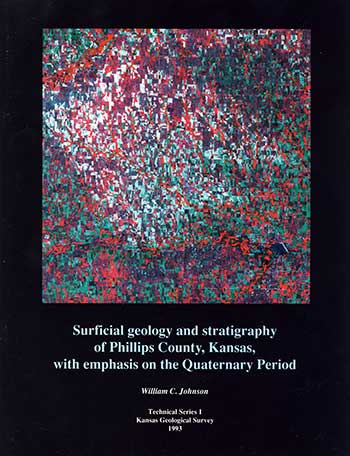Surficial geology and stratigraphy of Phillips County, Kansas, with emphasis on the Quaternary Period
By William C. Johnson

Originally published in 1993 as Kansas Geological Survey Technical Series 1. This is, in general, the original text as published. The information has not been updated. The publication supports the Phillips County geologic map and is also available as an Acrobat PDF file.
Abstract
Phillips County is located in northwestern Kansas adjacent to the Nebraska state line. It is also situated along the contact between the Smoky Hills and the High Plains physiographic regions, which is reflected in a diverse array of erosional and depositional Quaternary-age landscapes. Outcropping rock units, ranging in age from Upper Cretaceous to Holocene, include the Carlile Shale, the Niobrara Chalk, the Pierre Shale, the Ogallala Formation, and several unconsolidated Quaternary eolian and fluvial deposits. Although the Carlile Shale underlies the entire county, only a single, limited exposure exists; this outcrop occurs where an anticline has brought the Carlile sufficiently near the surface to be exposed at the base of a valley wall. The Niobrara Chalk consists of two distinct members, the Fort Hays Limestone Member and the Smoky Hill Chalk Member. Because exposures of the Niobrara Chalk occur increasingly higher in the section from south to north in the county, outcrops of the marine Fort Hays Limestone Member are confined to the south, particularly on the south side of Kirwin Reservoir. Outcrops of the Smoky Hill Chalk Member are common in the central and northern parts of the county, frequently with a cap of Ogallala rock. The Pierre Shale, the youngest outcropping Cretaceous rock, is preserved in the northwest in the downwarp of the Long Island syncline. The Miocene-age Ogallala Formation is composed of Rocky Mountain-derived fluvial sediments that progressively filled preexisting valleys and ultimately mantled the uplands. The three regionally recognized members cannot be easily differentiated in Phillips County. However, the carbonate-cemented mortar beds are conspicuous throughout the county, and silica-cemented sandstone lentils form a prominent cap rock in four areas of the county.
Late Quaternary deposits occur extensively, and those exposed range in age from pre-Illinoian to Holocene. Limited exposures of pre-Illinoian materials were reported by earlier researchers but were not recovered in this study. Illinoian stratigraphy consists of the Crete Formation, the Loveland Loess, and the Sangamon soil, which caps the Loveland; exposures of the Loveland and Sangamon are common throughout Phillips County. Sand and gravel of the Crete Formation represent an alluvial phase; the Loveland consists of a widely distributed loess. The Sangamon soil is a major pedogenic complex that apparently spans several tens of thousands of years. Wisconsin-age deposits include early to middle Wisconsin fluvial deposits, the Gilman Canyon Formation, the Peoria loess, and late Wisconsin fluvial deposits. The oldest fluvial deposits are unexposed but underlie the high terraces of the North Fork Solomon River and Prairie Dog Creek. The Gilman Canyon Formation is a loess and was deposited at a sufficiently slow rate to permit pedogenesis to continue in a more or less uninterrupted fashion, forming an isochronous, regionally expressed soil, or geosol. Subsequent loess fall, producing the Peoria loess, occurred toward the end of the Pleistocene and mantles most of the upland. Late Wisconsin fluvial deposits are poorly represented, and their distribution is uncertain.
Holocene stratigraphic elements include the Brady soil, the Bignell Loess, fluvial deposits, and eolian sand deposits. The Brady soil, developed within the top of the Peoria loess, appears discontinuously in Phillips County. Its presence is defined completely on the basis of the existence of overlying Bignell Loess. In most areas deposition of the Bignell has either not occurred or has been so minimal that the loess was incorporated into the surface soil, which developed at least initially within the uppermost Peoria loess. Holocene fluvial deposits occur either as a component of the high terrace or as post-1,000 yr B.P. floodplain deposits. The eolian sand deposits exist either as reworked point bar deposits situated on a low terrace of the North Fork Solomon River or as a large dune tract south of the river in the southwestern part of Phillips County.
Kansas Geological Survey, Geology
Placed on web Feb. 9, 2013; originally published 1993.
Comments to webadmin@kgs.ku.edu
The URL for this page is http://www.kgs.ku.edu/Publications/Bulletins/TS1/index.html